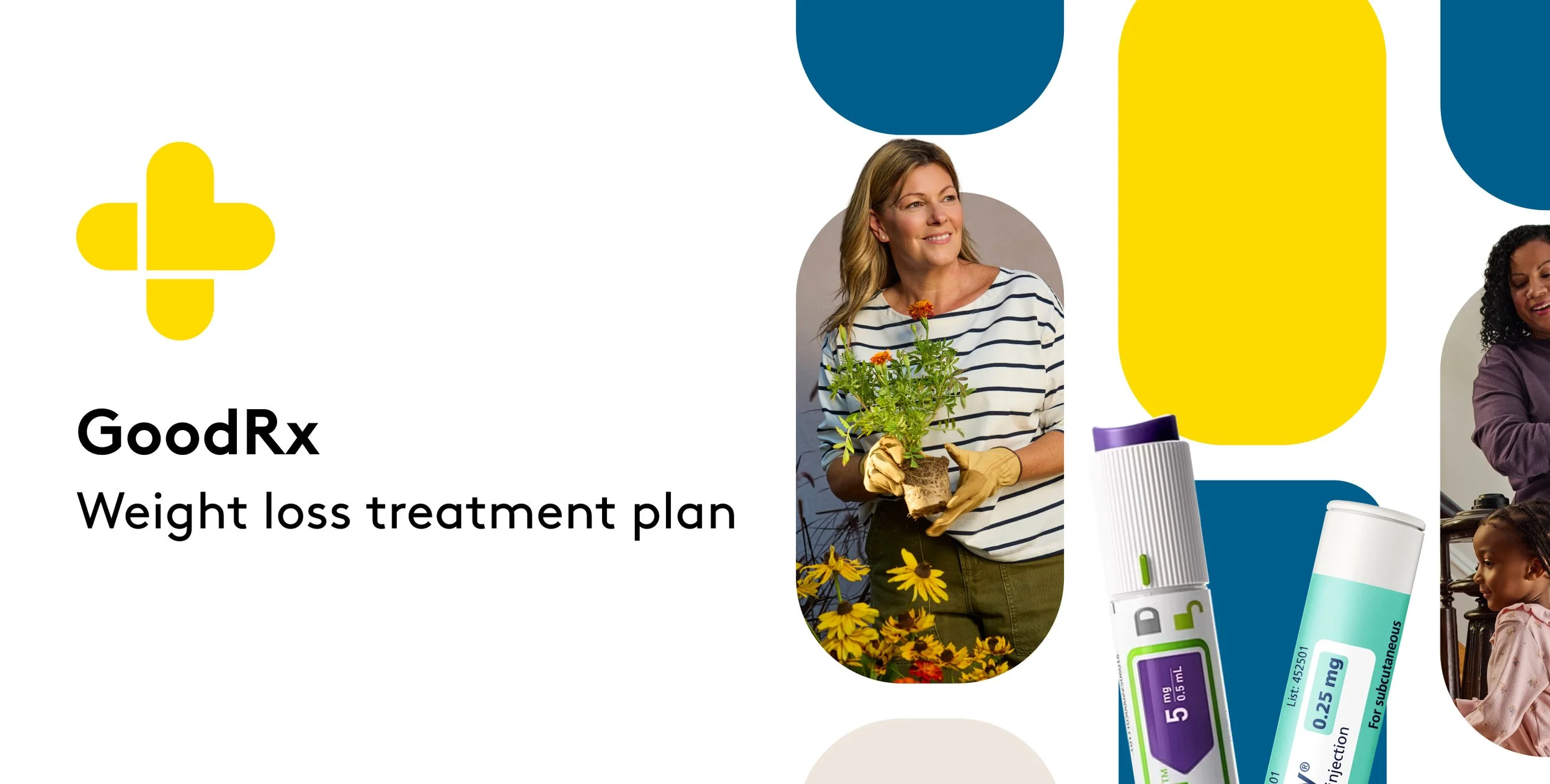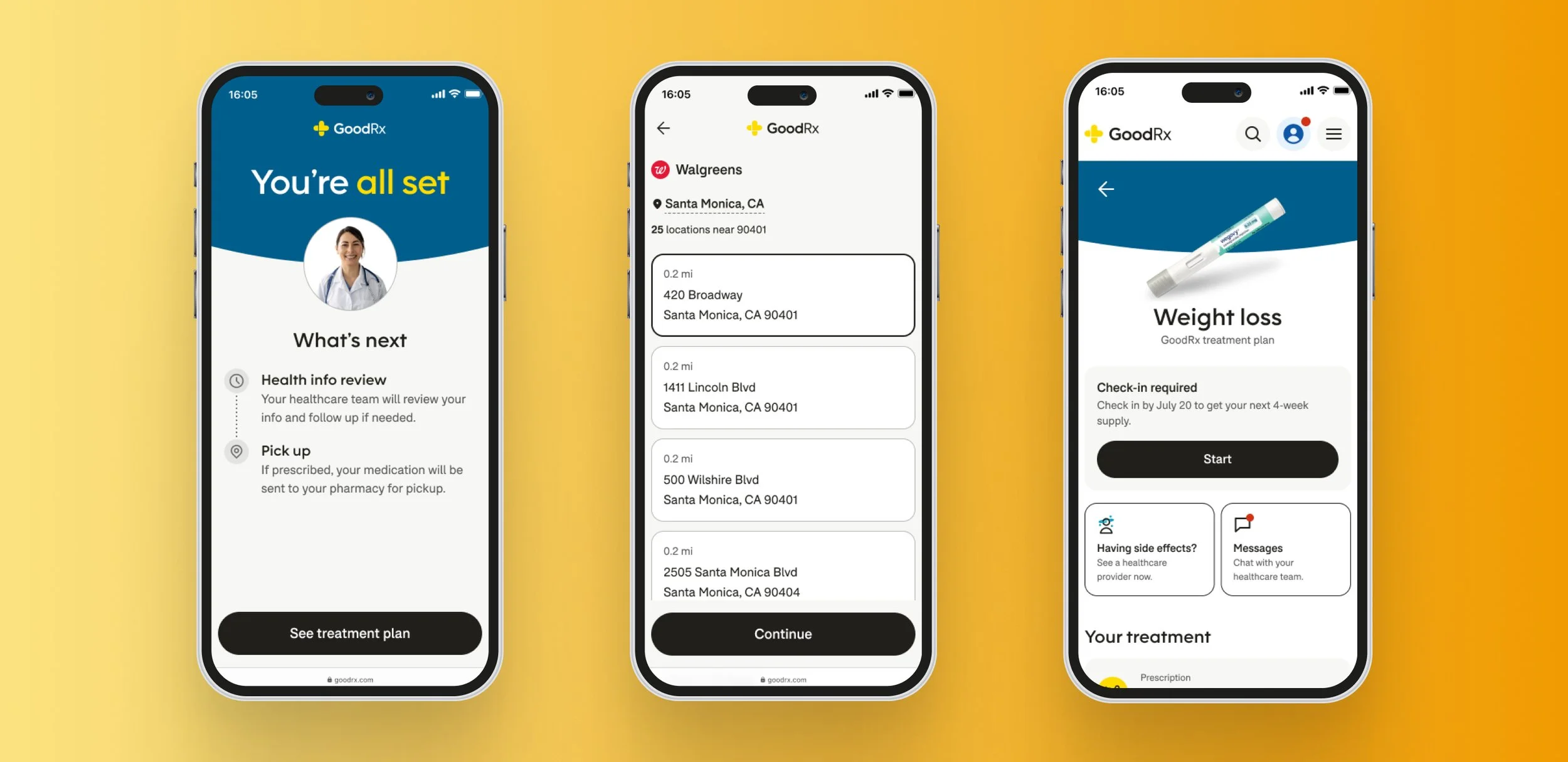Case Study: Weight loss
GoodRx empowers people to access affordable, transparent healthcare by helping them compare prescription prices, find discounts, and connect with telehealth providers.
Americans struggle with weight gain, obesity, and co-morbidities linked to excess weight. For many, losing weight is a difficult journey with conflicting advice, uneven results, and unmet promises. GLP-1s (and associated drugs) have in some ways been miracle drugs for many people.

Documentation
After the introduction of weight loss drugs, there have been multiple hurdles put in front of patients seeking these solutions. Synthesized together, a customer is looking for an easy way to get access to these drugs at affordable prices, with convenient and tailored care.
THE CHALLENGE
Bridging the gap
Our objective in this project was to increase our customer base via providing a weight loss treatment plan. By providing treatment plan to already existing & potential new customers, we added an additional method for customers to receive care. It was important for GoodRx to focus on working with patients looking to get access to the drugs at an affordable price.
Key objectives:
Designed a scalable care framework across multiple conditions
Simplify a complex, high-friction patient journey
Position GoodRx as a care partner beyond coupons
My role
I co-led the weight loss project between July 2025 to current. Worked alongside 1 product designer, 5 web engineer & 1 product manager.
Was working on the project from the beginning (research) to launch.
This first phase of this experience is expected to launch in Nov 2025.
PROCESS
Framework
UNDERSTAND
Competitive audit and did preliminary UXR studies with patients.
IDENTIFY
Identified core jobs needed to be done by weight loss patients.
EXECUTE
Conversations revealed their desire for GoodRx to make price transparency a top priority.
KICKOFF
How it started
Who
The primary end users were patients who were looking for the most affordable prices.
What
We needed to provide a way for patients to easily understand they would be paying the best prices in the market for specific drugs.
Why
GoodRx needed to expand market offerings diversity their business opportunities.
Insights
Pricing values
Patients consistently prioritized simple, all-in-one, and transparent pricing.
Affordability barrier
The $500+/month cost of GLP-1 medication was considered unaffodable by most participants.
Plan confusion
The original $79/mo headline was often misinterpreted as including medication, and this confusion led many participants to view the offer as misleading and deceptive.
DISCOVERY
Build trust early
From the beginning, our challenge was to help people navigate one of the most confusing and expensive healthcare journeys accessing GLP-1 weight loss medications. Patients were eager for solutions that actually worked, but faced barriers at every step: unclear eligibility, complex telehealth flows, and unpredictable pricing.
Our goal was to design a clear, trustworthy, and scalable experience that helped patients understand their options, feel confident in their care, and access medication faster while positioning GoodRx as a reliable guide beyond just coupons.
DEEPER INSIGHTS
What are the current issues?
It was a confusing and fragmented patient journey.
Lack of transparency in pricing coverage eroded trust and confidence.
Patients had limited perception of GoodRx’s role in care.
REFRAMING THE PROBLEM
Beyond the coupon
GoodRx wanted to evolve from being a coupon site to a care platform.
“How might we simplify their weight loss journey?”
As a result, how might we improve the patient experience so that the complex healthcare system feels approachable. Turning transactional users into long-term subscribers who trust GoodRx with their health journey.
Redesign.
Introducing agent referral program
With Opendoor's referral program, agents now have the ability to refer clients that are unable to continue working with.
Proposed flow

HOW WE GOT THERE
Who did what when?
Questions asked
How do agents interact with Opendoor?
What key pieces of information are they trying to understand?
How will we scale agent relationships in the future?
Challenges
Balancing amount of information early in the funnel vs. later
Integrating into agent workflows
Convincing agents to work with Opendoor
PIVOTS
What changed & why
Email first
In the first release, we focused primarily on an email entry for agents to test impact.
In-depth details
Originally, we wanted to pull in a comparison table within the product but we decided to push it to an email since our hypothesis was that it would drive more engagement.
Balance
The product needed to equally focus on refer or represent, however we needed to flag that refer was a new feature.
LAUNCH
What did we learn?
Agent-focused
By revamping the flow, we were able to gain more customers by helping agents choose a method that worked for their situation.
Education
We increased adoption of the referral program by adding an education screen to the top of funnel.
Handoff
We needed to improve our handoff so we made adjustments to make communication between Opendoor, agent, and customer as seamless as possible. We also added additional FAQ’s to address agent concerns.
METRICS
What was the impact?
Introduced referrals
Through referrals, we were successful in expanding our client base by 10 extra contracts/month during our trial period.
Improve UX
We streamlined the user experience by eliminating redundant screens and emphasizing the advantages agents gain from our services, thus improving overall conversion by 2%.
Building trust
Upon realizing that they would earn commission solely through referrals, agents were motivated to maintain their partnership with us.

